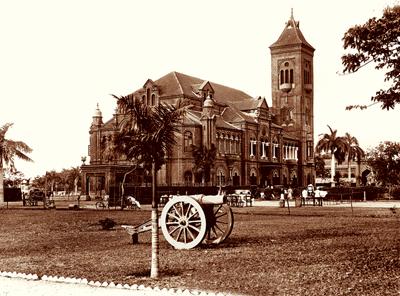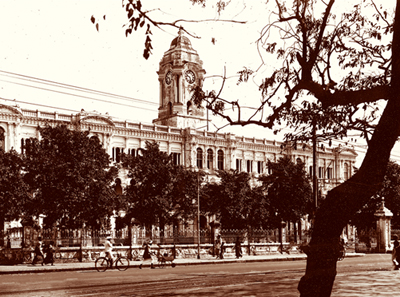|
Two of the heritage buildings in the city are undergoing restoration – the Victoria Public Hall and its neighbour, the Ripon Building. Both are multi-crore projects and, when completed, promise to be examples of what can be done with heritage structures in the city. Hooray, hooray!
 Victoria Public Hall (above) and Ripon Building (below): Will they look like these early 1920s views after restoration. (Pictures: Vintage Vignettes.) Victoria Public Hall (above) and Ripon Building (below): Will they look like these early 1920s views after restoration. (Pictures: Vintage Vignettes.)
|
There is, however, a doubt that is now plaguing conservationists. Is the restoration being done under proper supervision by experts in the field or is it simply yet another PWD project done according to the standard guidelines of the Government?
The recent pronouncements of those in charge of the restoration certainly point to the latter. A news item had a Government spokesman claiming that all four staircases adorning the Victoria Public Hall had been removed and will soon be replaced by new staircases. Those who have had the opportunity to visit this building in the past would agree that the staircases added to the beauty of the place and, barring the one leading to the tower, the others were definitely not structurally weak. Then why the decision to remove the staircases and what is the material and design chosen for the new ones? Will they be in harmony with the ambience of the building? Also, is it not one of the basic principles of heritage restoration to use, as much as possible, the existing material and, where that is not possible, to use what is closest to the original?
 |
VP Hall is not an isolated case. Recent discussions with architects in the city who are normally consulted by the Government prior to any heritage restoration show that, once the details are available, these projects are handed over to the PWD which proceeds according to its own lights. That means cost estimations for heritage projects are also done on the same basis as construction of new Government buildings, with standard rates for flooring, doors, windows and other elements. This, according to conservation experts, is certainly not correct. They are of the view that the estimate for a conservation project often changes after the building is opened up for repairs. As the work progresses, newer and more pressing problems often present themselves, resulting in having a fresh look at budgets at every stage. This is not understood by Government officials who are more comfortable working with fixed estimates and are also alarmed at the expense that heritage conservation often entails. Such projects, they find, cost far in excess of new building activities. They, therefore, often prefer bringing down a heritage structure to preserving it.
There is also the problem of availability of technicians. Heritage conservation is a specialist’s job calling for expert craftsmen who will not work for Government rates. To the powers-that-be, a mason is a mason no matter what be his specialisation. They are, therefore, reluctant to engage anyone at higher than standard wages. The routine workers come up with solutions that they are familiar with. Thus, Madras terrace is often replaced with RCC (as has been done at Amir Mahal), vitrified tiles are used to replace cuddappah stone (Madi Poonga), and plastic sheets have been put up in place of stained glass (the PWD building on the Marina). All these are extremely short-term solutions which work to the detriment of the heritage buildings in the long run. It is only very rarely that we come across a project like that of Senate House where, with the help of the right kind of expertise, a classic restoration was done.
All this points to the necessity for the Government to change its complete thinking on heritage.
It may have taken the first step towards conservation by putting a Heritage Conservation Committee in place, but to be effective, it needs to focus on proper guidelines and standards, the details of which need to be enshrined in an Heritage Act.
|